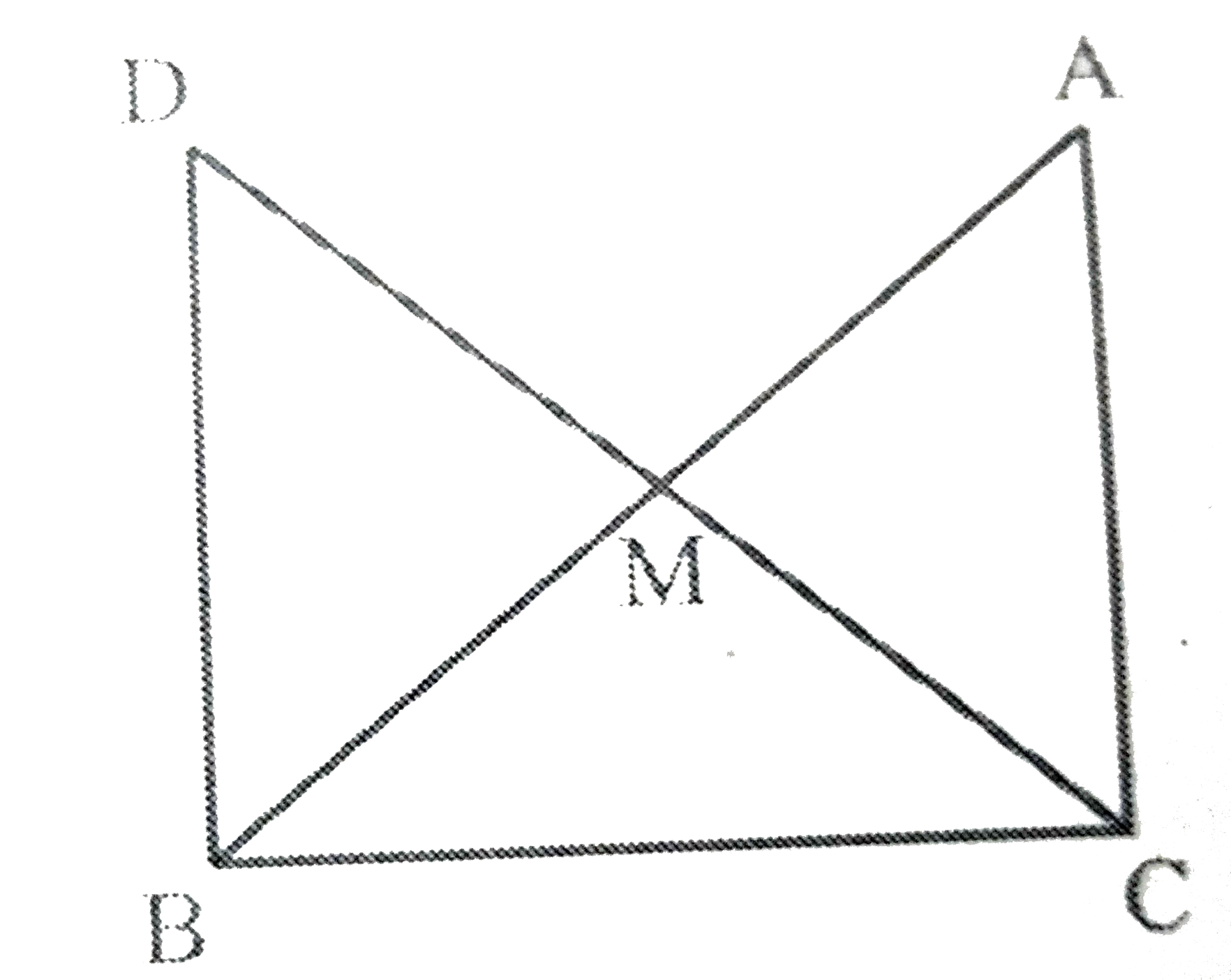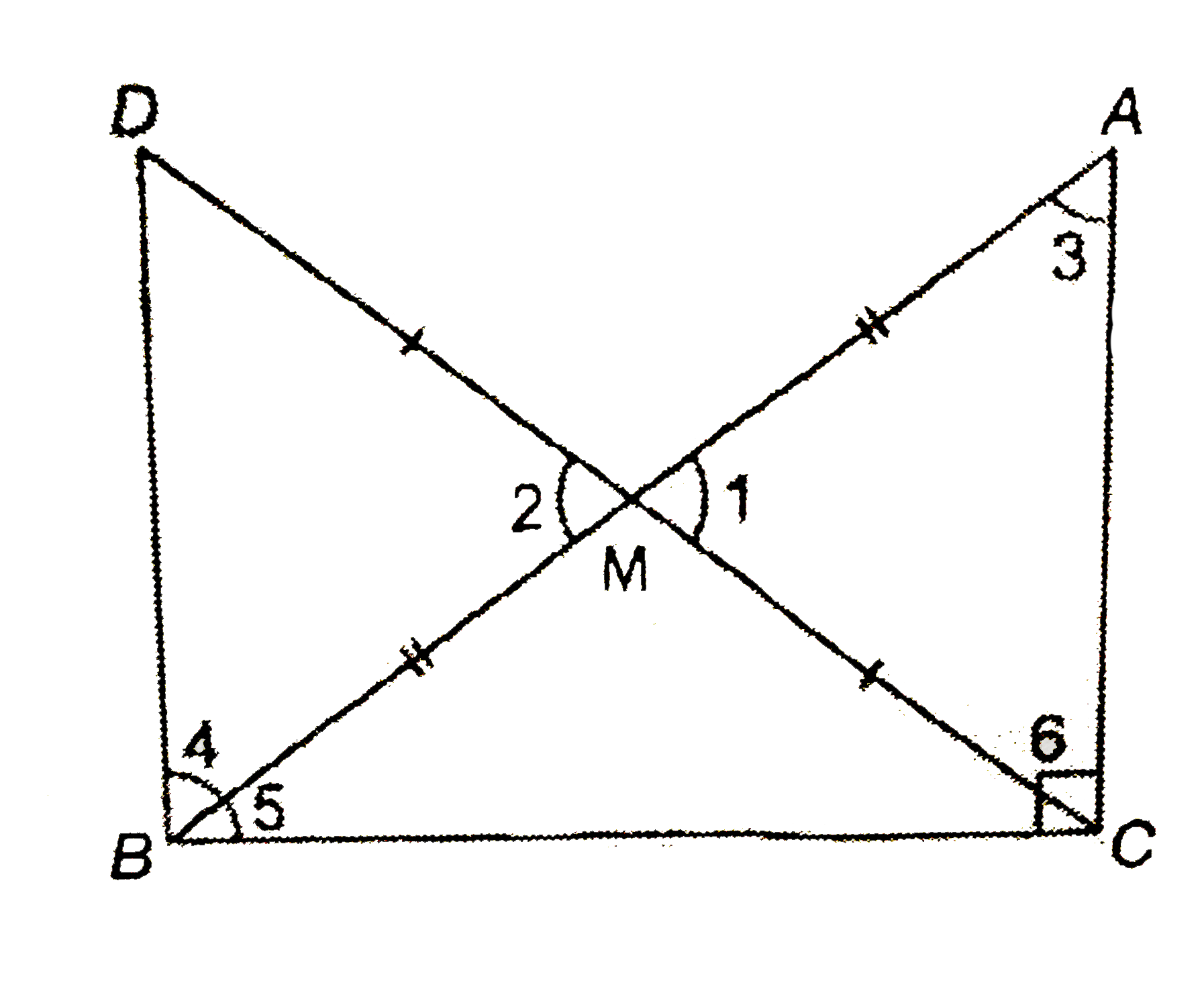In a right triangle ABC, right angled at C, P is the mid-point of hypotenuse AB. C is joined to P and produced to a point D, such that DP = CP. Point D is joined to point B. Show that:
CP=12AB
To solve the problem, we need to show that in triangle ABC, right-angled at C, with P as the midpoint of hypotenuse AB, and point D such that DP = CP, it follows that CP = (1/2)AB.
1. Identify the Triangle and Points:
Let triangle ABC be a right triangle with the right angle at C. Let P be the midpoint of the hypotenuse AB.
2. Establish the Lengths:
Since P is the midpoint of AB, we have:
AP=PB=12AB
3. Join Points:
Join point C to point P, and extend it to point D such that DP=CP. This means that D is located such that the length of segment DP is equal to the length of segment CP.
4. Use Congruent Triangles:
In triangles APC and BPD:
- AP=BP (since P is the midpoint of AB)
- DP=CP (given)
- ∠APC=∠BPD (by vertical angles)
By the Side-Side-Angle (SSA) congruence criterion, we can conclude that:
△APC≅△BPD
5. Corresponding Parts of Congruent Triangles:
From the congruence of triangles APC and BPD, we have:
AC=BD
6. Establish Parallel Lines:
Since AC is equal to BD and the angles ∠ACP and ∠DBP are equal (corresponding angles), we can conclude that:
AC∥BD
7. Use the Angle Sum Property:
Since AC∥BD, the angles ∠ACB+∠DBC=180∘. Given that ∠ACB=90∘ (as triangle ABC is right-angled), we have:
90∘+∠DBC=180∘⟹∠DBC=90∘
8. Establish Congruence of Triangles ACB and DBC:
Now, in triangles ACB and DBC:
- AC=BD (from earlier)
- ∠ACB=∠DBC=90∘
- CB=CB (common side)
Therefore, by the Side-Angle-Side (SAS) congruence criterion:
△ACB≅△DBC
9. Conclude the Lengths:
From the congruence of triangles ACB and DBC, we have:
AB=DC
Since P is the midpoint of AB, we can express:
CP=12AB
10. Final Conclusion:
Thus, we have shown that:
CP=12AB
Hence, it is proved.
Let triangle ABC be a right triangle with the right angle at C. Let P be the midpoint of the hypotenuse AB.
Since P is the midpoint of AB, we have:
AP=PB=12AB
Join point C to point P, and extend it to point D such that DP=CP. This means that D is located such that the length of segment DP is equal to the length of segment CP.
In triangles APC and BPD:
- AP=BP (since P is the midpoint of AB)
- DP=CP (given)
- ∠APC=∠BPD (by vertical angles)
△APC≅△BPD
From the congruence of triangles APC and BPD, we have:
AC=BD
Since AC is equal to BD and the angles ∠ACP and ∠DBP are equal (corresponding angles), we can conclude that:
AC∥BD
Since AC∥BD, the angles ∠ACB+∠DBC=180∘. Given that ∠ACB=90∘ (as triangle ABC is right-angled), we have:
90∘+∠DBC=180∘⟹∠DBC=90∘
Now, in triangles ACB and DBC:
- AC=BD (from earlier)
- ∠ACB=∠DBC=90∘
- CB=CB (common side)
△ACB≅△DBC
From the congruence of triangles ACB and DBC, we have:
AB=DC
Since P is the midpoint of AB, we can express:
CP=12AB
Thus, we have shown that:
CP=12AB
Hence, it is proved.
Topper's Solved these Questions
- CHAPTERWISE REVISION (STAGE 3) BOOK - ICSECHAPTER - CHAPTERWISE REVISION (STAGE 3) EXERCISE - ISOSCELES TRIANGLES
2 Videos
- CHAPTERWISE REVISION (STAGE 3) BOOK - ICSECHAPTER - CHAPTERWISE REVISION (STAGE 3) EXERCISE - INEQUALITIES
7 Videos
- CHAPTERWISE REVISION (STAGE 3) BOOK - ICSECHAPTER - CHAPTERWISE REVISION (STAGE 3) EXERCISE - LOGARITHM
9 Videos
- CHAPTERWISE REVISION (STAGE 1) BOOK - ICSECHAPTER - CHAPTERWISE REVISION (STAGE 1) EXERCISE - Graphical solution
10 Videos
- CIRCLEBOOK - ICSECHAPTER - CIRCLEEXERCISE - EXERCISE 17(D)
12 Videos
Similar Questions
In a right triangle ABC, right angled at C, P is the mid-point of hypotenuse AB. C is joined to P and produced to a point D, such that DP = CP. Point D is joined to point B. Show that:
Angle DBC is a right angle.
View SolutionIn a right triangle ABC, right angled at C, P is the mid-point of hypotenuse AB. C is joined to P and produced to a point D, such that DP = CP. Point D is joined to point B. Show that:
ΔAPC≅ΔBPD
View SolutionIn a right triangle ABC, right angled at C, P is the mid-point of hypotenuse AB. C is joined to P and produced to a point D, such that DP = CP. Point D is joined to point B. Show that:
ΔDBC≅ΔACB
View SolutionIn right triangle ABC, right-angled at C, M is the mid-point of hypotenuse AB. C is joined to M and produced to a point D such that DM = CM. Point D is joined to point B (see Fig. 7.23). Show that:
(i) ΔAMC≅ΔBMD
(ii) ∠DBC is a right angle
(iii) ΔDBC≅ΔACB
(iv) CM=12AB

View SolutionIn right triangle ABC , right angle at C, M is the mid-point of the hypotenuse AB. C is jointed to M and produced to a point D such that DM=CM. Point D is joined to point B. Show that AMC≅BMD (ii) ∠DBC=∠ACB DBC≅ACB (iii) CM=12AB
View SolutionIn right triangle ABC, right angle at C, M is the mid-point of the hydrotenuse AB. C is joined to M and produced to a point D such that DM=CM. Point D is joined to point B. Show that
(i) ΔAMC≅ΔBMD (ii) ∠DBC=∠ACB
(iii) ΔDBC≅ΔACB (iv) CM=12AB

View SolutionABC is a triangle right angled at C and M is mid-point of hypotenuse AB. Line drawn through M and parallel to BC intersects AC at D. Show that:
MD is mid-point of AC.
View SolutionIn a right ABC right-angled at C , if D is the mid-point of BC , prove that BC2=4 (AD2−AC2) .
View SolutionIn Fig. 3, ABC is a right triangle, right angled at C and D is the mid-point of BC. Prove that AB2=4AD2−3AC2.
View SolutionIf D is the mid-point of the hypotenuse AC of a right triangle ABC, prove that BD=12AC
View Solution
